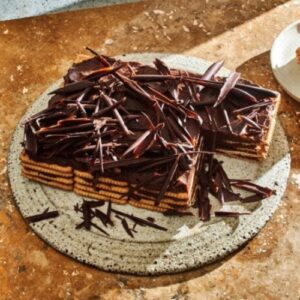Put the butter in a small bowl and beat with a flexible spatula until smooth; add ½ cup sugar and beat again with the spatula until it’s thoroughly incorporated.
Separate the egg, putting the yolk in a cup and the white in a small bowl; using a mixer or, for a short but strenuous exercise, a whisk, whip the white until it holds soft peaks; give the yolk a quick whisk, just to break it up; then stir it into the white.
Add the egg to the bowl with the butter and, using the spatula, stir and fold until blended; scrape in the melted chocolate; stir and fold again until the frosting is homogeneous; it will not be perfectly smooth; taste the buttercream and you will feel grains of sugar on your tongue – that is the way it is meant to be.
Pour the hot espresso into a wide, shallow bowl; stir in the remaining 1 tablespoon sugar.
One by one, drop each cookie into the espresso and count 3 seconds, flip it over, count 3 seconds more; place the espresso-soaked cookie on the serving plate; continue until you have your first layer of cookies in place.
Using a small offset spatula or a table knife, spread a quarter of the buttercream over the cookies, working the cream to the edges of the cookies.
Build 3 more layers of dunked cookies and smoothed buttercream.
Top the last layer of buttercream with grated chocolate.
Refrigerate the cake until the frosting is set; at least 3 hours.
The cake can be kept covered in the refrigerator for up to 3 days.
Once the frosting is set, the cake could also be wrapped airtight and frozen for up to 2 months.
To serve, simply let it defrost, still wrapped, in the refrigerator for about 4 hours or at room temperature for about 1 hour.
